The kayak’s deck is designed to accommodate an optional rudder and the designer could not attach the grab handle at the stern of the kayak since it would interfere with the rudder.
I have previously detailed the reasons why I regard some grab handles and its position on some kayaks dangerous. After a few pinched fingers and a bruised knuckles I now like to have all of my handles attached at the ends of my boats.
I believe that the best handle on a kayak is the single cord (not a loop) one from SKUK (Nigel Dennis).
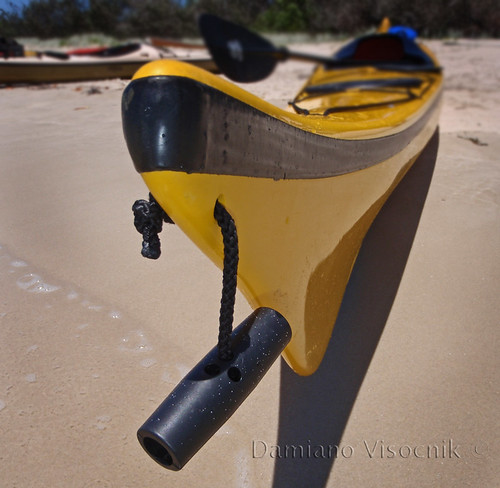
handle on SKUK Exporer
While some argue that it is not as easy to use in an emergency towing situation (no loop for a carabiner to be attached to) I prefer that type of set up to prevent injuring my fingers.
One thing that I don't like is the banging that the handles produces when the kayak is paddled in textured waters. Some other set ups (like Valley kayaks) have a bungee cord tensioning the handle back onto the deck which stops the annoying banging.
Then it dawned on me: why not combine the two? Why not tension the single line?
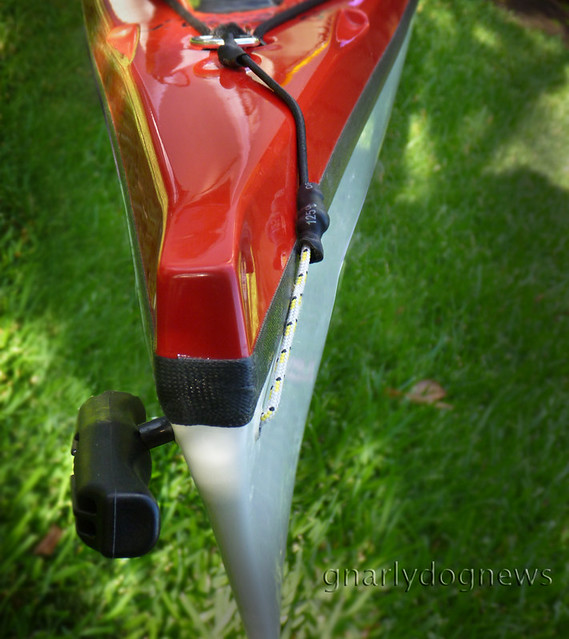
the handle was originally attached on top of the deck
While simple in concept the details of the execution and the quality of materials for this handle set up must be first rate.
I used a sheeted Dyneema core 4 mm line for the cord and quality bungee cord for the retracting/tension section.
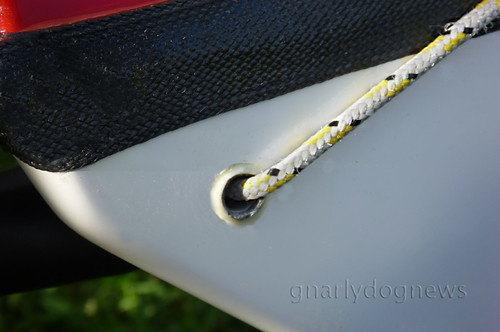
Dyneema line through a sleeve in the hull
A knot joins the two and a bit of heat shrink covers the ends to make it look neater. The knot stops the cord from being pulled through the sleeve in the hull. The bungee is attached to the toggle's original anchor point on deck.
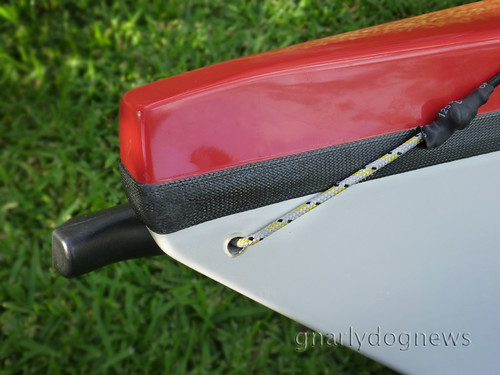
Dyneema/bungee junction
The handle has a short stand-off from the hull so it can be grabbed easily when in a hurry (like in the surf).
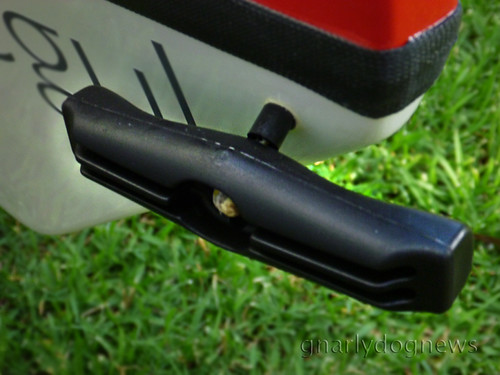
handle with stand-off
The idea of having a retractable handle came to me after I had drilled and sleeved the end of the hull of my kayak.
If I had to do it again I would position the sleeve on a slant to alleviate the (right) angle of the hole and have it more in line with the toggle cord. That would achieve less friction when the handle is pulled out and possibly reduce the wear on the line.
PS You have seen this set up here first

Brilliant!
ReplyDeleteDid you experiment with the amount of stand-off at all or this just looked right? Seems like a simple knot in between the handle and hull will also do the job.
The stand-off is high enough to create enough clearance for the hand to be able to grab the toggle in a hurry.
ReplyDeleteI guess one could experiment with more or less if needed. There is just a simple knot under that heat shrink.
Brilliant! So how do I do it for the plastic boats with no access to the pointy ends?
ReplyDeletePlastic boats are always more difficult to modify/outfit than composite boats since standard epoxy has a much harder time sticking to the plastic (PE) material.
ReplyDeleteI hear that some users have good luck with West System G-flex epoxy on PE boats but I have never tried it.
Drilling a hole and inserting a sleeve bonded to the hull with G-flex might work. You should experiment with the glue before committing drilling a hole in the hull.
On the photos the spacer looks like it's made from rubber/plastic hose rather than shrink wrap. I can't access the bigger images when I click on the link. Tells me I am not authorized to view them. Do I need to do something or are they protected on purpose?
ReplyDeleteHaris, you are correct: the spacer is a section of HDPE (plastic) pressure hose. I guess any type of decent plastic could be used for the spacer. Most of my images are protected and watermarked. After several instances of being "borrowed" without authorization I decided to make it harder to download them.
ReplyDeleteNovel solution, if I see it anywhere I will be sure to remember where I seen it first! I have however just got some bits to turn my annoying single cord banging SKUK toggle in to the Valley solution for some peace on the water, different strokes and all that ;)
ReplyDeleteHey, what great idea, I've got a NDK Explorer which I love except when I paddle in the tidal races of Anglesey I don't like the rattle. Whilst I do think the single strand is much safer than a loop I have been thinking of basing a modification on the P&H/Valley solution.Yours is much neater. I hope that I will not offend if I modify my own setup using your idea.
ReplyDeleteJohn, the reason I post my findings on this blog is for the kayak community to benefit from.
ReplyDeleteI will be glad if you use it but I would be upset if you tried to patent this idea like somebody else in USA has tried to patent the electric bilge pump (recent review in Sea Kayaker magazine).
I would like to keep my projects open source and not for profit.
Regarding adhesives for polyethelene boats. I have succesfully glued thigh straps and kneeling pads into a polyethelene white water canoe with "Mr Sticky's Polybonder" The strain on the thigh straps anchors when edging the boat is considrable, a good chunk of the paddlers weight.
ReplyDeletehttp://www.tapplastics.com/shop/product.php?pid=457&
Also see my post on Boater talk
http://boatertalk.com/forum/BoaterTalk/1520506/
Great kayak mod. Do you have a picture of how it looks from the cockpit? Just curious from a photography perspective, because I think kayaks photograph better without the end toggle in view.
ReplyDeleteBryan, I don't have an image of the kayak's end from the cockpit. That modification has been done to the stern of only one kayak. I am in the process of retrofittig the other kayaks.
ReplyDeletePlease, post a picture once you get the bow finished.
ReplyDeleteHi Gnarly,
ReplyDeleteGreat solution! I was wondering if the handle-to-boat spacer is fixed or floating free. On my Valley it floats free, which has caused more issue than the handle loop. I have had bits of skin removed from wet fingers when the handle, spacer and boat have separated and then come back together from wave motion etc. (courtesy of the bungee), with parts of said fingers now filling the gaps created.
Any thoughts?
Regards, Wayne
Wayne, the spacer is free floating like the Valley one. I understand what you mean but I have never experience it since I always wear gloves when paddling (to prevent sunburn and cuts when handling boats). Could you tie a knot just after the spacer to prevent it from sliding away from the handle?
ReplyDeleteGnarly I also wear gloves for sun protection, though most of the year I wear the half finger type and this has enabled the pinching. I feel a knot is not the answer, but you have made me think and I may have another solution, I'll let you know, if it works.
ReplyDeleteRegards, Wayne
Might I suggest having the cord run all the way to the handle, with enough slack to pull out, and have the bungee attached to the D-ring and the cord, so the bungee keeps the cord pulled in until the handle is grabbed, but isn't bearing the load? Cord and bungee both attached to the ring, bungee stretched and attached to the cord on top of the deck to keep it pulled in, cord through the hole and attached to the handle.
ReplyDeleteMike, thank you for your idea.
ReplyDeleteCould you send me a basic sketch and perhaps I could recreate it in a composite image? of course you could also create the real deal and submit your images for inclusion in the article.